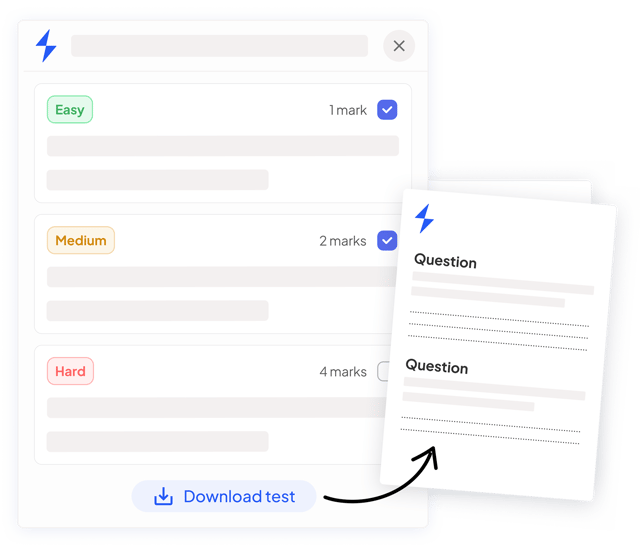Newton's Laws of Motion (Cambridge (CIE) A Level Physics): Revision Note
Exam code: 9702
Newton's three laws of motion
Newton's first law
Newton’s First Law of Motion states that:
A body will remain at rest or move with constant velocity unless acted on by a resultant force
If the forces acting on an object are balanced, the object is said to be in equilibrium
There is no resultant force (the resultant force = 0)
There is no change in the object's motion
If the object was moving at a constant velocity, it will continue to move at that constant velocity
If the object was at rest, it will remain at rest
If the forces acting on an object are not balanced:
There is a resultant force
There is a change in the object's motion
The object may speed up (acceleration)
The object may slow down (negative acceleration)
The object may change direction (a change in velocity, hence acceleration)
Worked Example
A car is moving at a constant velocity in the forward direction.
The driving force exerted by the engine on the car is 6 kN.
Frictional forces oppose the motion of the car. State the magnitude of the frictional forces acting on the car.

Answer:
Step 1: Determine whether the forces acting on the car are balanced
The car is traveling at a constant velocity
Therefore, there is no resultant force acting on the car
Hence, the forces are balanced
Step 2: Determine the magnitude of the frictional forces acting on the car
The forward and backward forces are balanced
Therefore, the frictional forces are equal to the driving force
The magnitude of the frictional forces = 6 kN
Newton's second law
Newton's second law of motion describes the change in motion that occurs when the forces acting on an object are not balanced
Newton's second law can be stated as:
A resultant force acting on a body will cause a change in the object's motion in the direction of the force
Newton's second law can also be stated in terms of momentum:
The rate of change in momentum is proportional to the magnitude of the force
Newton's second law can also be written as:
Where:
F = force in newtons (N)
m = mass in kilograms (kg)
a = acceleration in metres per second squared (m s-2)
Worked Example
A girl is riding her skateboard down the road and increases her speed from 1 m s-1 to 4 m s-1 in 2.5 s.
The force driving her forward is 72 N. Calculate the combined mass of the girl and the skateboard.

Answer:
Step 1: List the known quantities
Force, F = 72 N
Initial velocity, vi = 1 m s-1
Final velocity, vf = 4 m s-1
Step 2: State the equation for Newton's Second Law
Step 3: State the equation for acceleration
Step 4: Substitute the acceleration equation into Newton's Second Law
Notice here that the change in momentum equation emerges
Step 5: Rearrange to solve for mass
Step 6: Substitute the known values to calculate
Newton's third law
Newton’s third law of Motion describes the force interaction between two different objects
Whenever two bodies interact, the forces they exert on each other are equal and opposite
If body A exerts a force on body B, then body B will exert a force on body A of equal magnitude but in the opposite direction
Therefore, forces always occur in pairs
A Newton's third law force pair must be:
the same type of force
the same magnitude
opposite in direction
acting on different objects
Worked Example
A physics textbook is at rest on a dining room table. Eugene draws a free-body force diagram for the book and labels the forces acting on it.

Eugene says the diagram is an example of Newton's third law of motion. William disagrees with Eugene and says the diagram is an example of Newton's first law of motion.
By referring to the free-body force diagram, state and explain who is correct.
Answer:
Step 1: State Newton's first law of motion
Objects will remain at rest, or move with a constant velocity unless acted on by a resultant force
Step 2: State Newton's third law of motion
Whenever two bodies interact, the forces they exert on each other are equal and opposite
Step 3: Check if the diagram satisfies all of the conditions for identifying Newton's third law
Newton's third law applies for pairs of equal and opposite forces of the same type, acting on two different objects
The forces in the diagram act on only one object
Furthermore, the forces acting on the object are different types of force; one is the normal contact force (of the table on the book) and the other is the gravitational force (of the Earth on the book); its weight
The image below shows how to apply Newton's third law correctly in this case, considering the pairs of forces acting:

Step 4: Conclude which person is correct
In this case, William is correct
The free-body force diagram in the question is an example of Newton's first law
The book is at rest because the two forces acting on it are balanced - i.e. there is no resultant force
Examiner Tips and Tricks
Just because you see two forces in opposite directions doesn't mean they are a Newton's third law force pairs! You must remember the specific criteria.

Newton’s Third Law force pairs are only those that act on different objects
You may also have heard Newton’s Third Law as: ‘For every action is an equal and opposite reaction’. However, try and avoid using this definition since it is unclear which forces are acting on which object and can therefore be misleading.
Ready to test your students on this topic?
- Create exam-aligned tests in minutes
- Differentiate easily with tiered difficulty
- Trusted for all assessment types

Did this page help you?